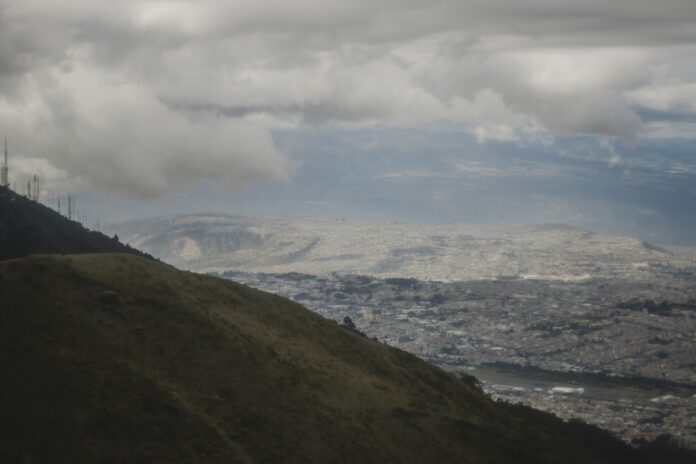Latin America is widely known for its beautiful landscapes, warm people and some of the world’s most biodiverse environments. Of the 33 countries that form this region, Ecuador stands out as one of the smallest in territory. Yet, it’s the fourth most megadiverse country behind Brazil, Mexico and Colombia, according to the United Nations on Biological Diversity.
Last month, the country was hit with the worst drought in 60 years and multiple widespread wildfires that threaten its biodiversity.
How did we get here?
Ecuador has numerous microclimates in its four regions, which makes it hard to dictate specific seasons.
Depending on where you are located, you can experience different types of weather. For example on the Coast winters consist of rain and humid heat and in the Amazon, you can experience tropical weather due to the rainforest. More specifically, the Andes Mountain range – where Quito is located – has a dry season from August to September. Combined with high UV Radiation which causes faster wind forces, it creates the perfect scenario for bigger and more devastating forest fires.
Climate change has worsened this environmental problem, which was forecasted years ago and was featured as part of the national debate between the presidential candidates in 2023. The prevention of the droughts was pointed out to be a critical strategic point to guarantee the domestic energetic demand.
Climate change is not the only thing to blame for these forest fires. Many are saying the fires are man-made, including Quito’s mayor.
Pabel Muñoz, Quito’s mayor, said they are cataloging the fires as “criminal and terrorist.”
Related: Ecuadorian students react to political crisis, violence at home
Ecuadorians react
Alejandra Baca is a third-year international student from Ecuador and she agrees with Muñoz.
“It is very obvious that the forest fires were set, so you know it’s by people who want to create worse conditions for Ecuadorians and citizens of Quito specifically. It feels very bad because the only thing you can do is watch the news, talk to your family and hope everyone is doing okay,” said Baca. “Nothing is improving, being far from home and being able to do nothing about it is very frustrating.”
Felipe Rivadeneira is a law student at Universidad Hemisferios in Quito, Ecuador. He added that municipal and regional governments have had bad management of the emergency.
“There is a big lack of prevention plans and a heavily inefficient fire brigade which worsens the situation,” said Rivadeneira.
Ecuador has been experiencing a decrease in rains since 2023 which has impacted water reservoirs, agricultural and livestock production as well as energy generation.
This is a crucial issue since 70 per cent of the domestic energy production is produced with hydropower. Starting Sept. 18, the government has been forced to impose national electricity cut schedules to ration the energy supply.
“Electricity effects drastically the quality of life for Ecuadorians, even more for the ones who depend on it to work, which is basically all of us … It is very draining when a sector faces an electricity cut and I’m stuck hours on the highway because the traffic light doesn’t have energy to work,” said Rivadeneira.
What is the root cause?
According to the Ecuadorian Business Committee, over $12 million USD are lost each hour the country faces an electricity cut.
Although Ecuadorians are pointing at the government for the mismanagement in this hydro-crisis, climate change is worsening the current situation.
“Everybody’s looking for someone to blame in the short term, like this administration or that administration. But of course, these climate changes are driven by global forces,” said Janice Harvey, environment and society professor at St. Thomas University.
“Countries like Ecuador, simply don’t have the economic capacity to kind of build their way out of it,” said Harvey.
She explains how the correlation between the droughts, the unprecedented low water reservoirs and the wildfires is not being perceived by the Ecuadorian citizens.
Harvey said these issues are being tackled as separate problems, which have created a lot of stress for the residents.
Because of that, Harvey believes that the main problem connecting all of these events, climate change, is not being properly addressed, or even addressed at all.
“It’s a chronic problem of not connecting the dots,” said Harvey. “Sort of understanding, really, that the causes of all of this disruption are systemic and structural and long-standing.”
“[People] have to look back to the global processes of trying to get climate change agreements in place and actually implement [an] effective climate change policy, which we’re still not getting.”
Harvey said that what’s necessary to address the root cause of the problem is holding accountable the industrialized countries, who have built their wealth by burning fossil fuels and have heavily contributed to the creation of the issues climate change has caused globally.
By addressing the root cause of the problem, Harvey believes countries like Ecuador, which “contribute next to nothing to the overall global problem,” won’t continue to be effected by the repercussions of climate change.

